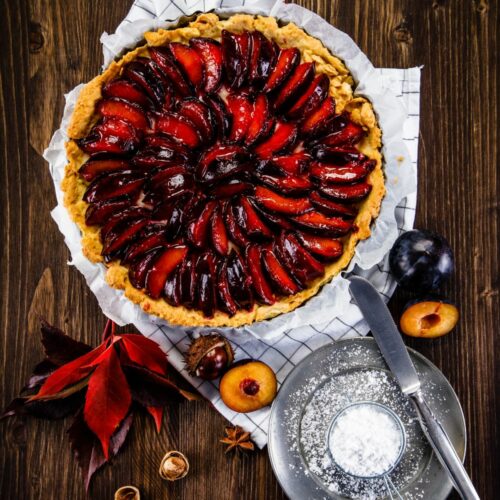Plum Tarte Tatin is an elegant, upside-down tart that combines the richness of crème pâtissière with the natural sweetness of plums. My version, inspired by James Martin’s original, has been tweaked to elevate the flavors and create a more generous serving, perfect for family gatherings or special occasions.
How Was This Recipe Named?
The name “Plum Tarte Tatin” elegantly encapsulates both the key ingredient and the culinary technique used in its creation. The term “Plum” directly points to the star of the show, plums, which infuse the tart with their distinctive sweet and tangy flavor, as well as a burst of vibrant color. The latter part of the name, “Tarte Tatin,” is a nod to the classic French upside-down pastry.
This unique style of tart was popularized by the Tatin sisters in the late 19th century at their hotel in Lamotte-Beuvron, France. As the story goes, the Tarte Tatin was born somewhat accidentally when one of the sisters, in a hurry to prepare a dessert, started cooking apples for a traditional pie in butter and sugar but then decided to put the pastry on top and finish it in the oven.
The result was a beautifully caramelized upside-down tart, which soon became a beloved culinary creation. Thus, combining “plum” with “Tarte Tatin” not only describes the dessert’s main ingredient and its preparation method but also pays homage to the classic French culinary tradition from which it draws inspiration.
How To Make Plum Tarte Tatin James Martin Recipe Overview:
This recipe takes the classic Plum Tarte Tatin and amplifies it for a more decadent experience. It involves preparing a luscious crème pâtissière and a beautifully caramelized plum topping, all resting on a buttery puff pastry base. The process will take approximately 2 hours, including preparation and cooking time, and will yield a tart suitable for serving around 8-10 people.
Ingredients:
For the Crème Pâtissière (makes around 900g):
- 1 large vanilla pod, split and seeds scraped out
- 600ml full-fat milk
- 6 egg yolks
- 60g cornflour
- 30g butter
- 150g caster sugar
- Icing sugar for dusting (optional)
For the Roasted Plum Tart:
- Butter, for greasing
- 60g melted butter
- 600g high-quality, all-butter puff pastry
- Flour, for dusting
- 120g crème pâtissière (from above)
- 10 plums, halved, stoned, and cut into wedges
Instructions:
- Start with the crème pâtissière. In a saucepan, heat the milk with the vanilla pod and seeds until just boiling. In a bowl, whisk the egg yolks and sugar. When the mixture becomes pale, whisk in the cornflour. Gradually pour the hot milk into the egg mixture, whisking continuously. Return the mixture to the saucepan. Now cook over low heat. Stir constantly until the mixture thickened. Remove from heat, stir in the butter, and set aside to cool. Cover with cling film to prevent skin from forming.
- Preheat your oven to 190°C (375°F). Grease a round baking tin with butter and dust it with flour.
- Roll out the puff pastry on a floured surface to a thickness of about 5mm. Cut a circle slightly larger than your baking tin and set it aside.
- Spread the crème pâtissière evenly over the base of the tin. Arrange the plum wedges in a circular pattern on top of the cream. Drizzle the melted butter over the plums.
- Carefully lay the pastry over the plums, tucking the edges down around the fruit. Bake for 25-30 minutes until the pastry is golden and puffed up.
- Let the tart cool in the tin for a few minutes, then carefully invert onto a serving plate. Dust with icing sugar if desired.
Recipe Tips:
Choose the Right Plums: For the best flavor, use ripe but firm plums. Overripe plums can become too mushy during cooking.
Roll the Pastry Evenly: Ensure your puff pastry is rolled out evenly. This helps in even cooking and a uniformly golden crust.
Preheat Your Oven: Always start with a preheated oven for consistent baking results.
Watch the Caramelization: When preparing the plum layer, keep an eye on the caramelization process. It should be a golden brown, not too dark, to avoid bitterness.
Use Quality Puff Pastry: Opt for high-quality, all-butter puff pastry for the best flavor and texture.
Let It Rest Before Flipping: After baking, let the tart cool for a few minutes in the tin. This makes it easier to invert onto a plate without falling apart.
Serve Warm: For the best taste experience, serve the tart warm. It brings out the flavors and makes the pastry more enjoyable.
Don’t Overfill: Be careful not to overfill the tart with crème pâtissière and plums, as this could make the pastry soggy.
Storage and Reheating: If you have leftovers, store them in the fridge and reheat in the oven for a few minutes before serving to revive the pastry’s crispness.
Also Read: James Martin’s Classic Pea and Ham Soup Recipe
Nutritional Value (Per Serving)
Calories: 450 kcal
Fat: 27 g
Saturated Fat: 16 g
Carbohydrates: 45 g
Sugar: 22 g
Protein: 6 g
Sodium: 150 mg
FAQs:
Can I use store-bought crème pâtissière?
Using store-bought crème pâtissière is a great time-saver for this recipe. Many high-quality versions are available, offering a convenient alternative to making it from scratch. It’s important, though, to choose a brand that has a rich flavor and creamy texture to ensure your Plum Tarte Tatin turns out delicious. Simply follow the instructions on the packaging for use. This shortcut can make the baking process much easier, especially if you’re short on time or new to making pastries. It’s a practical and effective solution for busy bakers.
How can I ensure the pastry doesn’t get soggy?
To prevent your pastry from getting soggy, start by rolling it thin. This helps it cook thoroughly and become crisp. Before assembling, make sure the crème pâtissière and plums are not too wet. You can also brush the pastry with a little beaten egg, creating a barrier that prevents moisture from seeping in. When baking, ensure your oven is properly preheated and bake the tart until the pastry is fully golden and puffed up. This helps to create a nice, flaky layer that isn’t overwhelmed by the moisture from the fruit and cream below.
Can other fruits be used instead of plums?
You can certainly use other fruits instead of plums in this recipe. Apples, pears, or peaches are great alternatives. These fruits also caramelize beautifully and add their unique flavors to the tart. Just slice them thinly and arrange them as you would with plums. Remember to adjust the baking time slightly if needed, as different fruits may have varying moisture content. Experimenting with different fruits can add a delightful twist to the classic Tarte Tatin and allows you to customize the dessert based on what’s in season or your personal preferences.
How long can I store the tarte tatin?
You can store the Tarte Tatin in the refrigerator for up to two days. It’s best to keep it in an airtight container to maintain its freshness and prevent it from absorbing other odors. While the tart can be eaten cold, it tastes even better when gently reheated. Simply warm it in the oven for a few minutes before serving. However, remember that the pastry might not retain its original crispness after refrigeration. It’s always best enjoyed fresh, but storing it properly can still leave you with a delightful dessert for a later treat.
Can this recipe be made gluten-free?
Yes, you can make this recipe gluten-free quite easily. The key substitution is using gluten-free puff pastry, which is readily available in many supermarkets and health food stores. Ensure that the pastry is certified gluten-free to avoid any cross-contamination. For the crème pâtissière, check that all ingredients, like cornflour, are also gluten-free. Most other ingredients in the recipe are naturally gluten-free, like milk, sugar, and plums. This simple switch allows you to enjoy a delicious gluten-free Plum Tarte Tatin without compromising on the taste or texture of this classic dessert.
Conclusion:
My version of James Martin’s Plum Tarte Tatin offers a delightful twist to the classic, making it an indulgent treat perfect for any occasion. Remember, the key to a perfect tarte tatin lies in the caramelization of the fruit and a flaky pastry crust. Enjoy the process and the delicious results!

Plum Tarte Tatin James Martin Recipe
Ingredients
For the Crème Pâtissière (makes around 900g):
- 1 large vanilla pod split and seeds scraped out
- 600 ml full-fat milk
- 6 egg yolks
- 60 g cornflour
- 30 g butter
- 150 g caster sugar
- Icing sugar for dusting optional
For the Roasted Plum Tart:
- Butter for greasing
- 60 g melted butter
- 600 g high-quality all-butter puff pastry
- Flour for dusting
- 120 g crème pâtissière from above
- 10 plums halved, stoned, and cut into wedges
Instructions
- Start with the crème pâtissière. In a saucepan, heat the milk with the vanilla pod and seeds until just boiling. In a bowl, whisk the egg yolks and sugar. When the mixture becomes pale, whisk in the cornflour. Gradually pour the hot milk into the egg mixture, whisking continuously. Return the mixture to the saucepan. Now cook over low heat. Stir constantly until the mixture thickened. Remove from heat, stir in the butter, and set aside to cool. Cover with cling film to prevent skin from forming.
- Preheat your oven to 190°C (375°F). Grease a round baking tin with butter and dust it with flour.
- Roll out the puff pastry on a floured surface to a thickness of about 5mm. Cut a circle slightly larger than your baking tin and set it aside.
- Spread the crème pâtissière evenly over the base of the tin. Arrange the plum wedges in a circular pattern on top of the cream. Drizzle the melted butter over the plums.
- Carefully lay the pastry over the plums, tucking the edges down around the fruit. Bake for 25-30 minutes until the pastry is golden and puffed up.
- Let the tart cool in the tin for a few minutes, then carefully invert onto a serving plate. Dust with icing sugar if desired.

